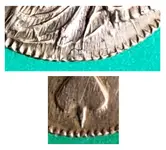Aureus
Silver Member
- Joined
- Sep 5, 2016
- Messages
- 4,222
- Reaction score
- 8,365
- Golden Thread
- 4
- Location
- Eastern Canada
- 🥇 Banner finds
- 4
- 🏆 Honorable Mentions:
- 2
- Detector(s) used
- XP DEUS 2
- Primary Interest:
- Relic Hunting
Last edited:
I agree it's George II ('Old Head'). I've seen a lot of these with similar reverse designs, but I don't recall ever seeing one with George II on the obverse. They're almost always George III and, less frequently, Victoria. Even the George III ones are usually actually nostalgic pieces made in Victoria's reign. As you probably know, they're colloquially known as 'whist tokens' but would have been used in card fames of all kinds. They're commonly the same size as guinea and half-guinea or sovereign and half-sovereign.
Thanks for the info Red-Coat. This one is way smaller than anything I have seen before, about the size of a 3 pence. Also, It looks better made and older than any Victorian gaming or whist tokens I have seen. It's strange, but I can't find a single example online of this type.

Personally I don't buy into that theory, I think it's German made mass (or low numbers) produced.A couple of other observations. Zooming in, I see what look like shrinkage features around various edges of the high relief portions of the design on both sides. Notably at the bottom of the spade and the base of the King’s bust for example:
View attachment 1802530
These are one of the tell-tales we use to help determine cast fake ancient coins from authentic hammered or struck ones. I think this piece has been cast, not struck. Those rivulet-like features are typically created when molten metal cools and shrinks away from a mould.
The workmanship for the obverse is clearly superior to the reverse. I suspect the obverse portion of the mould was created from the impression of a George II coin with the legend then erased and the reverse portion of the mould was ‘home-produced’ from scratch. It suggests that this token is a ‘cottage industry’ product, not a commercially-made one.
A couple of other observations. Zooming in, I see what look like shrinkage features around various edges of the high relief portions of the design on both sides. Notably at the bottom of the spade and the base of the King’s bust for example:
View attachment 1802530
These are one of the tell-tales we use to help determine cast fake ancient coins from authentic hammered or struck ones. I think this piece has been cast, not struck. Those rivulet-like features are typically created when molten metal cools and shrinks away from a mould.
The workmanship for the obverse is clearly superior to the reverse. I suspect the obverse portion of the mould was created from the impression of a George II coin with the legend then erased and the reverse portion of the mould was ‘home-produced’ from scratch. It suggests that this token is a ‘cottage industry’ product, not a commercially-made one.
Where would the obverse legend fit?
